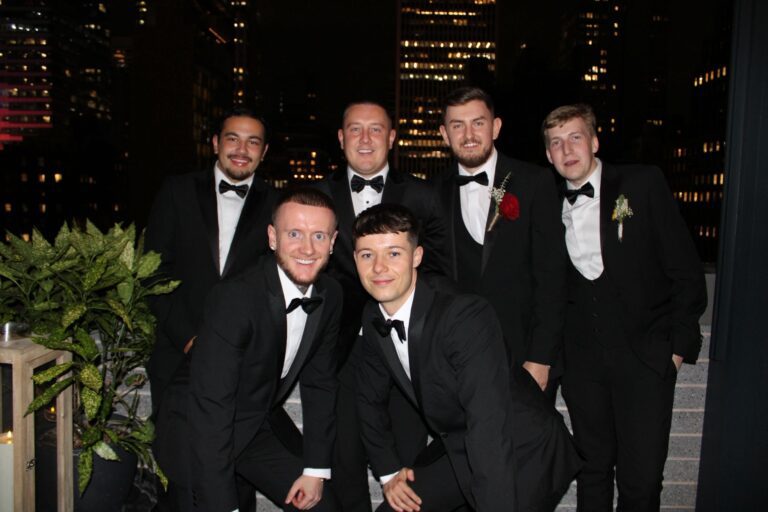Weddings have always been a significant milestone in a person’s life, marked by traditions, celebrations, and elaborate attire. While much focus has traditionally been placed on the bride’s gown, the groom’s wedding attire has also undergone remarkable transformations throughout history. Let’s take a journey through time to explore how men’s wedding attire has evolved, reflecting changes in societal norms, fashion trends, and cultural influences.
Ancient and Medieval Times
In ancient civilisations, men’s wedding attire varied significantly across cultures. In ancient Rome, grooms typically wore a toga virilis, symbolizing manhood and citizenship. It was often made from plain white wool, reflecting purity and modesty. Similarly, in ancient Egypt, grooms donned simple linen robes, sometimes adorned with colourful sashes or jewellery, signifying their social status.
During the medieval period in Europe, weddings were grand affairs, especially among the nobility. Grooms wore their finest garments, often richly decorated and made from luxurious fabrics like velvet and silk. The colours were vibrant, with reds, blues, and golds being popular choices. These garments not only signified wealth and status but also served as a reflection of the groom’s family heritage and alliances.
The Renaissance and Baroque Eras
The Renaissance era which spanned from the 14th century to the end of the 16th century (circa 1300-1600), brought a renewed interest in art, culture, and fashion. Men’s wedding attire during this period became even more extravagant. Doublets, hose, and cloaks adorned with intricate embroidery and embellishments were common. Grooms often wore matching outfits with their brides, symbolising unity and harmony. The emphasis was on elegance, with fabrics like brocade, satin, and taffeta being central to wedding attire.
Continuing on from this, the Baroque period, which spanned from the late 16th century to the mid-18th century (circa 1580-1750), continued this trend of opulence. Men’s wedding attire featured elaborate wigs, lace cuffs, and ruffled collars. Coats and waistcoats were adorned with gold and silver thread, and accessories like gloves, hats, and canes completed the ensemble. The overall look was one of grandeur and sophistication, reflecting the lavishness of the times.
The Victorian Era
The Victorian era marked a significant shift in men’s wedding attire, influenced by the reign of Queen Victoria and her marriage to Prince Albert. The more formal morning suit became the standard for grooms, consisting of a tailcoat, waistcoat, and trousers. Black, dark blue, and gray were the favoured colours, signifying formality and sobriety.
This period also saw the introduction of the boutonnière, a small flower worn in the lapel of the groom’s jacket, symbolising love and fidelity. Top hats and gloves were popular accessories, completing the polished and refined look that defined Victorian wedding attire.
The 20th Century
The 20th century was a century of change which brought about significant changes in men’s wedding fashion, reflecting broader social and cultural shifts.
The Early 1900s
In the early 1900s, the morning suit remained popular, but there was also a growing trend towards the lounge suit, a more relaxed and comfortable option. This period saw the rise of the tuxedo, particularly for evening weddings. The tuxedo, characterised by its satin lapels and formal appearance, became a staple of men’s formalwear.
The 1950s and 1960s
The mid-20th century witnessed a mix of tradition and modernity. While the tuxedo remained popular, some grooms began opting for slim-fitting suits and narrow ties, reflecting the influence of Hollywood and the emerging youth culture. Colours became more varied, with lighter shades like beige and pastel blue gaining popularity.
The 1970s and 1980s
The 1970s and 1980s were decades of experimentation and bold fashion choices. Grooms embraced trends like wide lapels, flared trousers, and bold colours. Velvet and ruffled shirts were also in vogue, reflecting the era’s flamboyant style. These decades were marked by a departure from traditional norms, with grooms expressing their individuality through their wedding attire.
Contemporary Trends: 1990s to Today
The late 20th and early 21st centuries have seen a return to classic and timeless styles, combined with a modern twist. The tuxedo remains a popular choice, but grooms now have a wide array of options, from traditional three-piece suits to more casual ensembles.
Today, men’s wedding attire is characterised by a focus on fit, quality, and personalisation. Custom-made suits and bespoke tailoring are highly sought after, allowing grooms to create a look that is uniquely their own. Colours range from classic black and navy to more adventurous hues like burgundy and emerald green. Accessories such as pocket squares, cufflinks, and stylish shoes add a touch of individuality and flair.
There is no one definitive style of wedding suit. The groom can choose a suit that reflects his style and the formality of the wedding. However, the morning suit remains a popular choice for many grooms, as it is classic and elegant.
Moreover, cultural and destination weddings have influenced contemporary groom fashion, with attire that reflects the location or cultural heritage. From traditional kilts in Scottish weddings to colourful sherwanis in Indian ceremonies, men’s wedding attire continues to evolve, embracing both tradition and innovation.
Conclusion
The history of men’s wedding attire is a fascinating reflection of changing societal norms, cultural influences, and fashion trends. From the opulence of the Renaissance to the classic elegance of the Victorian era and the modern emphasis on personalisation, grooms have always found ways to express their style and identity on their special day. As we look to the future, one thing is certain: men’s wedding attire will continue to evolve, celebrating both tradition and individuality in equal measure.
What we do know is that at Salters, we will continue to supply an extensive selection of suits for grooms and their groomsmen including kilts and accessories. If you would like to find out more, why not make an appointment to come and see us?

